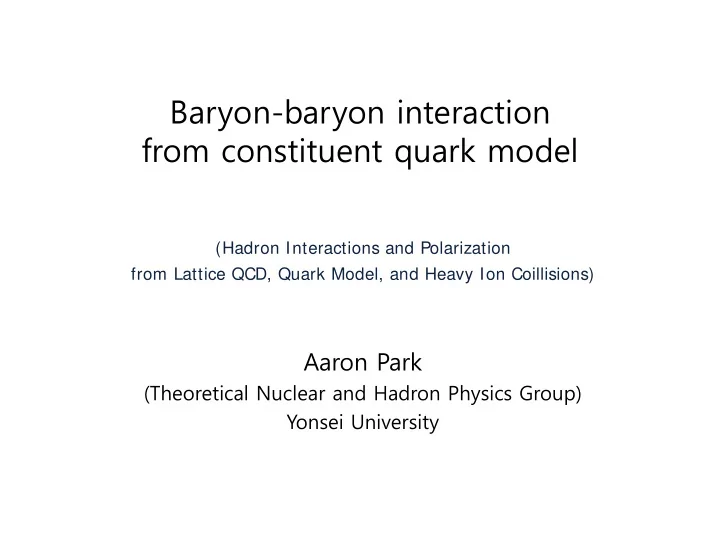

Baryon-baryon interaction from constituent quark model (Hadron Interactions and Polarization from Lattice QCD, Quark Model, and Heavy Ion Coillisions) Aaron Park (Theoretical Nuclear and Hadron Physics Group) Yonsei University
1. BB Interaction - collaborated with T. Hatsuda, T. Inoue, S. H. Lee 2. BBB Interaction - collaborated with S. H. Lee YITP HIPLQH2019
Baryon-baryon interaction 1 4 2 3 5 6 𝑠 → 0 YITP HIPLQH2019
Baryon-baryon interaction 1 4 2 3 5 6 𝑠 → 0 1 3 2 4 5 6 Dibaryon configuration YITP HIPLQH2019
Baryon-baryon interaction baryon ⊗ baryon dibaryon YITP HIPLQH2019
Baryon-baryon interaction in lattice QCD (SU(3) symmetric limit) HAL QCD Collaboration, Prog. Theo. Phys. 124 (2010) 591 YITP HIPLQH2019
Baryon-baryon interaction in Quark Model baryon ⊗ baryon dibaryon Wave function = Orbital ⊗ Color ⊗ Flavor ⊗ Spin [6] 𝑃 [222] 𝐷 [33] 𝐺𝐺 𝑒 ∗ (2380) ΩΩ 𝐼 dibaryon 𝑂Ω B. Silvestre-Brac and J. Leandri, Phys. Rev. D 45, 4221 (1992) YITP HIPLQH2019
Flavor state of dibaryon 𝐼 -dibaryon : 𝐺 27 𝐺 1 𝑂Ω : 𝐺 27 𝐺 8 𝑒 ∗ : 𝐺 10 ΩΩ : 𝐺 28 YITP HIPLQH2019
Comparion with Lattice QCD In SU(3) symmetric case YITP HIPLQH2019
Baryon-baryon interaction in lattice QCD (SU(3) broken) T. Inoue, QNP2018 conference YITP HIPLQH2019
Hamiltonian : confinement potential : hyperfine potential YITP HIPLQH2019
In SU(3) flavor symmetry breaking case We choose the following Jacobi coordinate and spatial part of the wave function satisfying [1234][56] symmetry. In order to satisfy the Pauli exclusion principle, we construct the remaining flavor- color-spin part of the wave function to satisfy {1234}{56} symmetry. YITP HIPLQH2019
Additional kinetic energy Static binding potential 1 4 𝑦 3 𝑦 5 𝑦 1 𝑦 4 𝑦 2 3 2 6 5 qqs+qqs : ΛΛ or ΣΣ qqq+qss : 𝑂Ξ YITP HIPLQH2019
Color-spin interaction in SU(3) broken case YITP HIPLQH2019
Color-spin interaction in SU(3) broken case 𝑛 𝑣 = 𝑛 𝑒 = 1 -24 8 8/3 8/3 -28/3 YITP HIPLQH2019
Baryon-baryon interaction in Quark model YITP HIPLQH2019
Comparison with Lattice QCD SU(3) symmetric case SU(3) broken case YITP HIPLQH2019
Transformation coefficients S-wave orbital M. Harvey, Nucl. Phys. A 352, 301 (1981) YITP HIPLQH2019
Transformation coefficients Baryon ⊗ baryon Dibaryon YITP HIPLQH2019
Transformation coefficients and SU(3) isoscalar factors YITP HIPLQH2019
Summary of BB interaction 1. We construct orbital-flavor-color-spin wave function of the dibaryon satisfying the Pauli exclusion principle. We estimate the baryon-baryon interaction in a compact multiquark configuration. 2. For both SU(3) flavor symmetric case and SU(3) flavor symmetry broken case, we conclude that our results show good agreement with lattice QCD results at short distance region. YITP HIPLQH2019
1. BB Interaction - collaborated with T. Hatsuda, T. Inoue, S. H. Lee 2. BBB Interaction - collaborated with S. H. Lee YITP HIPLQH2019
Hyperon puzzle in neutron stars Massive ( 2 𝑁 ⨀ ) neutron stars vs softening of EOS by hyperon mixing Hyperon puzzle YITP HIPLQH2019
Hyperon puzzle in neutron stars Massive ( 2 𝑁 ⨀ ) neutron stars vs softening of EOS by hyperon mixing Hyperon puzzle Y. Sakuragi, PTEP 2016 (2016) 06A106 D. Lonardoni et al, PRL 114, 092301 (2015) YITP HIPLQH2019
Three-body interaction 1 1 2 3 2 3 1 2 3 YITP HIPLQH2019
Three-body interaction 1 1 2 3 2 3 1 2 6 3 4 8 1 9 7 5 2 3 Tribaryon configuration YITP HIPLQH2019
Orbital state of tribaryon 3 × 3 = 6 + 51 + 42 + [33] YITP HIPLQH2019
Orbital state of tribaryon antisymmetric 3 × 3 = 6 + 51 + 42 + [33] symmetric YITP HIPLQH2019
Orbital state of tribaryon In terms of baryon, there are four possibilities. YITP HIPLQH2019
Color state of the tribaryon Wave function = Orbital ⊗ Color ⊗ Flavor ⊗ Spin [9] Meson Baryon Tetraquark Pentaquark Dibaryon Tribaryon Tetrabaryon # of color 1 1 2 3 5 42 462 basis YITP HIPLQH2019
Flavor state of the tribaryon Wave function = Orbital ⊗ Color ⊗ Flavor ⊗ Spin [9] [333] Flavor and spin states of tribaryon : YITP HIPLQH2019
Hyperfine potential SU(3) flavor symmetric limit 𝐿 𝑢𝑢𝑢𝑢𝑢𝑢𝑢𝑢𝑢 𝐿 𝐶1 + 𝐿 𝐶2 + 𝐿 𝐶3 YITP HIPLQH2019
Hyperfine potential where 𝐷 𝐷𝐺 is the constant that depend on the spatial part of the wave function, which we will take to be universal for all physical states composed of s-wave quarks. YITP HIPLQH2019
Strangeness = − 1 Λ𝑂𝑂 Σ𝑂𝑂 ⋮ YITP HIPLQH2019
Strangeness = − 2 ΛΛ𝑂 ΛΣ𝑂 ΣΣ𝑂 Ξ𝑂𝑂 ⋮ YITP HIPLQH2019
S = − 3 ΛΛΛ ΛΛΣ ΛΣΣ ΞΛ𝑂 ΞΣ𝑂 ⋮ YITP HIPLQH2019
Strangeness = − 4 ΞΛΛ ΞΛΣ ΞΣΣ ΞΞ𝑂 ⋮ YITP HIPLQH2019
Strangeness = − 5 ΞΞΛ ΞΞΣ ΩΛΛ ΩΞ𝑂 ⋮ YITP HIPLQH2019
Strangeness = − 6 ΞΞΞ ΩΞΛ ΩΞΣ ΩΩ𝑂 ⋮ YITP HIPLQH2019
𝐶 1 𝐶 2 𝐶 3 𝑈 YITP HIPLQH2019
𝐶 1 𝐶 2 𝐶 3 𝐸 1 𝑈 YITP HIPLQH2019
𝐶 1 𝐸 2 𝐶 2 𝐶 3 𝑈 YITP HIPLQH2019
𝐶 1 𝐸 3 𝐶 2 𝐶 3 𝑈 YITP HIPLQH2019
𝐶 1 𝐸 2 𝐸 3 𝐶 2 𝐶 3 𝐸 1 𝑈 YITP HIPLQH2019
Pure three-body force YITP HIPLQH2019
Transformation coefficients Baryon ⊗ baryon Dibaryon YITP HIPLQH2019
Transformation coefficients Tribaryon Baryon ⊗ Dibaryon YITP HIPLQH2019
Transformation coefficients Tribaryon Baryon ⊗ Dibaryon Tribaryon Baryon ⊗ Dibaryon YITP HIPLQH2019
Summary of BBB interaction 1. We have identified compact tribaryon configurations in terms of SU(3) flavor and spin quantum numbers that are allowed within the Pauli principle. 2. While compact configurations are possible for certain quantum numbers, we found that the color-spin interaction for all the allowed configurations are highly repulsive with respect to three baryon channel. 3. This is the microscopic proof that the three body nuclear force should be repulsive in all channels, which are consistent with the recently established neutron star mass limit. YITP HIPLQH2019
Thank you YITP HIPLQH2019
Recommend
More recommend